#TraditionalCalligraphy
Explore tagged Tumblr posts
Text
Street Art Calligraphy Styles: Urban Meets Traditional

Street Art Calligraphy Styles: Discover the Mesmerizing Fusion of Urban and Traditional Art
In the world of street art, typography and calligraphy intertwine to create a captivating fusion of urban and traditional artistic styles. From the dynamic letterforms adorning city walls to the expressive strokes of handwritten scripts, street art calligraphy styles bring a unique aesthetic to the urban landscape. Street art calligraphy styles encompass the diverse range of artistic techniques used to manipulate letterforms, fonts, and handwriting styles. This form of artistic expression merges the rebellious nature of graffiti with the elegance and precision of calligraphy, resulting in visually striking artworks that challenge traditional art forms. Typography and calligraphy in street art go beyond mere decoration. They serve as powerful vehicles for conveying messages, celebrating cultural heritage, and sparking conversations. By visually interpreting language and adding an extra layer of depth to the urban environment, street artists inspire urban typography as a whole, influencing city signage, advertising, and branding. From contemporary calligraphic murals to graffiti-infused typography, street art calligraphy styles exemplify the dynamic and ever-evolving nature of urban artistic expression. They speak to the vibrancy and diversity of city life, capturing the essence of the communities they inhabit. Key Takeaways: - Street art calligraphy styles merge urban flair with traditional artistic techniques, creating visually captivating artworks. - Typography and calligraphy in street art convey powerful messages and influence urban typography as a whole. - Street art calligraphy styles celebrate cultural heritage and showcase the diversity of urban communities. - Street art calligraphy adds depth and beauty to the urban landscape, inspiring creativity and sparking conversations. - Street art calligraphy is a dynamic and ever-evolving form of artistic expression that reflects the vibrancy of city life.
Typography in Political Activism

When it comes to political activism, typography plays a pivotal role in voicing powerful messages through street art. Artists skillfully employ impactful fonts to demand attention and ensure that their art's intended message reaches a broad audience. The use of typography as a tool in political activism allows artists to spark meaningful conversations and raise awareness about pressing social and political issues. By leveraging bold and attention-grabbing fonts, street artists create visually compelling artworks that leave a lasting impact on viewers. The inherent power of typography lies in its ability to instantly capture attention and convey meaning. Whether it's a call to action, a critique of power structures, or a plea for social justice, the choice of fonts in political street art plays a crucial role in effectively delivering the intended message. "Typography in political street art is a necessity. It enables artists to translate complex political ideas into visual form, ensuring that powerful messages are not just heard but seen by the masses." - Street Artist Through the strategic use of impactful fonts, political street art demands engagement, incites thought, and elicits emotional responses. It serves as a powerful means of expressing dissent, challenging the status quo, and mobilizing communities towards action. In a society where attention spans are decreasing, typography in political activism offers a way to captivate audiences and convey complex ideas concisely. By leveraging powerful messages through innovative typographic techniques, street artists can effectively break through the noise and provoke meaningful conversations about important social and political issues. The Language of Typography Typography, as a visual language, transcends barriers and speaks directly to the emotions of individuals. The choice of fonts, colors, and arrangement of text in political street art becomes a potent tool for influencing public opinion and shaping narratives. Moreover, impactful typography creates a sense of urgency, demanding attention and actively involving the viewer in the conversation. It empowers individuals to become active participants in the political discourse and fosters a collective sense of ownership and responsibility for societal change. Political street art utilizes typography not only to express dissent but also to unify communities around a common cause. By employing powerful fonts and messages, artists create a shared visual language that communicates solidarity, resistance, and hope. With the rise of social media and digital platforms, typography in political activism has extended its reach beyond the physical urban landscape. Campaign slogans, hashtags, and viral memes embody the essence of impactful fonts in engaging a global audience and mobilizing collective action. In conclusion, typography in political activism serves as a catalyst for change, inspiring conversations, raising awareness, and mobilizing communities. Through the careful selection of fonts and the creation of powerful messages, street artists harness the visual power of typography to shape public opinion, challenge societal norms, and advocate for a more just and inclusive world.
Calligraphy's Timeless Elegance
Amidst the chaotic urban landscape, calligraphy brings a sense of timeless elegance and sophistication to street art. The art form's intricate strokes and graceful curves elevate street art's aesthetic, showcasing artistic mastery and captivating viewers with its beauty. Calligraphy in street art holds a unique allure. Through the skillful manipulation of letterforms and handwritten scripts, artists create visually stunning compositions that command attention and ignite a sense of wonder. The fusion of calligraphy and street art forms a dynamic interplay between the written word and visual expression, captivating audiences and sparking conversations. The artistic mastery of calligraphy lies in the artist's ability to transform ordinary surfaces into captivating works of art. Each carefully crafted stroke and curve carries intention and purpose, resulting in a harmonious combination of form and meaning. Whether it's the bold brushstrokes of Chinese calligraphy or the delicate lettering of ornamental scripts, calligraphy adds depth and richness to the urban landscape. The timeless elegance of calligraphy extends beyond its aesthetic appeal. It's a testament to the power of the written word and the impact it has on society. By incorporating calligraphy into street art, artists create a visual narrative that engages viewers on a deeper level, evoking emotions and leaving a lasting impression. Calligraphy's presence in street art not only showcases the artistic abilities of its creators but also fosters a greater appreciation for the beauty of the written word. It encourages viewers to pause and reflect, experiencing the artistic expression firsthand. Calligraphy in street art serves as a powerful reminder of the intricate artistry and the boundless possibilities that can be achieved through the interplay of language and creativity.
Merging Art and Language

Typography and calligraphy merge art and language in street art, creating a harmonious interplay between the written word and visual expression. Street artists skillfully combine the aesthetics of typography and calligraphy to craft visually stunning compositions that captivate viewers and evoke powerful emotions. By integrating the written word into their artwork, street artists transform ordinary urban spaces into vibrant canvases that convey deep and meaningful messages. Each stroke, curve, and letter is carefully chosen to enhance the overall visual impact and narrative of the piece. The fusion of art and language allows for dynamic storytelling through captivating visuals. Bold and expressive typography demands attention, drawing viewers into the narrative woven within the artwork. The interplay between written word and visual expression creates a unique and immersive experience, engaging passersby and inviting them to interpret the artwork in their own way. Typography and calligraphy merge art and language in a way that transcends traditional modes of communication. Through visually striking compositions, street artists challenge conventions and push boundaries, showcasing the power of artistic expression in urban environments. The seamless integration of art and language extends beyond mere aesthetics. It fosters a deeper connection between individuals and their surroundings, bridging the gap between visual art and written communication. Through the medium of street art, artists can convey powerful messages, evoke emotions, and spark conversations that resonate with a diverse audience. The Impact of Artistic Fusion The merging of art and language in street art has a profound impact on the urban landscape. It transforms mundane city walls into galleries of creativity and self-expression. By infusing written word with visual artistry, street artists breathe life into urban spaces, sparking curiosity and enriching communities. Benefits of Merging Art and Language in Street Art Examples in Street Art 1. Inspiring engagement and dialogue 1. The vibrant murals in Wynwood Walls, Miami 2. Amplifying cultural and social messages 2. The thought-provoking works by Banksy 3. Creating visually stunning compositions 3. The intricate calligraphy graffiti by Pokras Lampas 4. Transforming urban spaces into artistic experiences 4. The immersive street art installations by Alexandre Farto, also known as Vhils Merging art and language through typography and calligraphy in street art not only heightens the visual appeal of the urban landscape but also fosters a sense of connection and identity within communities. It celebrates the interplay between creativity and communication, leaving a lasting impression on both the physical cityscape and the hearts of those who encounter it.
Cultural Celebration

Typography and calligraphy in street art offer a platform for cultural celebration, honoring the diversity and unique identities within communities. Street artists skillfully incorporate elements of local scripts and writing styles into their artwork, paying homage to the cultural heritage that shapes and defines their neighborhoods. "Street art allows us to celebrate our roots and express our identities in a visual and vibrant way. It's a powerful form of community representation that showcases the rich tapestry of cultures and languages that exist within our city streets." - Local street artist, Sofia Rodriguez Through the visual medium of typography and calligraphy, street artists create stunning compositions that tell stories and convey narratives deeply rooted in their cultural backgrounds. By using local scripts and writing styles, they capture the essence of their communities and share it with the world. Whether it's the graceful flowing lines of Arabic calligraphy, the intricate brushstrokes of Chinese characters, or the vibrant colors of indigenous symbols, street art celebrates the uniqueness and vibrancy of different cultures. It acts as a visual representation of the diverse narratives and experiences that thrive within a community. Here is an example of how calligraphy in street art can pay tribute to cultural heritage: Local Script Country/Culture Description Arabic calligraphy Middle East and North Africa Bold and elegant script featuring intricate lines and curves, often used to convey poetic verses and religious texts. Hangeul South Korea Simplified and symmetrical characters that form the basis of the Korean writing system, representing the unique phonetic structure of the Korean language. Mayan hieroglyphics Maya civilization, Central America Ancient writing system characterized by pictorial symbols representing sounds and ideas, conveying the rich history and mythology of the Mayan culture. By incorporating local scripts and writing styles, street artists not only express their cultural roots but also contribute to a sense of inclusive representation, allowing individuals from diverse backgrounds to see themselves reflected in the urban landscape. Through cultural celebration in street art, typography and calligraphy become powerful means of fostering a connection between art, language, and community. They inspire a sense of pride and unity, encouraging individuals to embrace their heritage and share it with the world.
Playful Typography in Urban Spaces

Playful and unconventional typography in street art adds an element of surprise and delight to the urban landscape. Street artists transform ordinary signage and lettering into whimsical works of art that engage and captivate passersby. This unconventional approach to typography breaks the monotony of everyday life and invites viewers to interact with their surroundings in a more playful and imaginative way. The juxtaposition of unexpected letterforms and vibrant colors creates a visually stimulating experience that puts a smile on people's faces. Whether it's a mural with whimsical lettering dancing across a wall or an eye-catching installation that combines unconventional typography with playful elements, street artists use their creativity to create captivating artworks that leave a lasting impression. These whimsical works of art serve as a form of self-expression for the artists while also engaging the community and sparking conversations. "Playful typography in street art allows artists to inject a sense of fun and whimsy into the urban environment. It's a way of challenging traditional lettering and exploring new possibilities of visual expression." Engaging passersby is an essential aspect of street art, and playful typography achieves just that. Whether it's through clever wordplay, optical illusions created by unconventional lettering, or hidden messages waiting to be discovered, street artists capture the attention and curiosity of those who encounter their art. The interactive nature of these artworks encourages people to pause, reflect, and immerse themselves in the artistic experience. Examples of Playful Typography in Street Art Here are a few examples of playful typography in street art: Artwork Description https://www.youtube.com/watch?v=Rt15_OclsyI A vibrant mural featuring whimsical lettering intertwined with colorful illustrations, creating an enchanting visual narrative. An unconventional lettering installation that incorporates interactive elements, allowing viewers to rearrange the letters and create their own words. An optical illusion created by using unconventional letterforms that play with perspective, challenging viewers' perception of space and reality. These examples showcase the boundless creativity and imagination of street artists who use playful typography to transform urban spaces into whimsical and interactive galleries.
Conclusion
Street art calligraphy styles seamlessly blend the urban flair of street art with the traditional art form of calligraphy, resulting in a dynamic fusion of art and language that leaves a lasting impression on the aesthetics of cityscapes. Whether conveying powerful political messages, celebrating cultural heritage, or creating visually stunning compositions, street art calligraphy styles captivate viewers and shape our interaction with the written word in the vibrant tapestry of city life. Typography and calligraphy in street art go beyond mere decoration. They serve as powerful tools for political activism, with impactful fonts and bold lettering demanding attention and sparking conversations about important social and political issues. Additionally, the timeless elegance of calligraphy adds sophistication to the chaotic urban landscape, showcasing the artistic mastery behind the intricate strokes and graceful curves. Cultural celebration is another prominent aspect of street art calligraphy styles. By incorporating elements of local scripts and writing styles, street artists pay homage to the unique identity of their communities and foster a sense of representation. The playful and unconventional typography found in street art adds a touch of whimsy to urban spaces, turning mundane signage into engaging works of art that invite passersby to interact with their surroundings in a more imaginative way. As street art continues to evolve, typography and calligraphy will remain influential forces in shaping the aesthetics of cityscapes and our relationship with the written word. The dynamic fusion of art and language found in street art calligraphy styles continues to inspire urban typography, influencing everything from city signage to advertising and branding. Street art calligraphy styles are a testament to the power of creativity, bridging traditional and contemporary art forms and breathing life into the city streets.
FAQ
How do typography and calligraphy contribute to street art? Typography and calligraphy in street art add an extra layer of depth and beauty to the urban landscape. They merge art and language, creating visually captivating artworks that inspire urban typography as a whole. Typography and calligraphy in street art also influence city signage, advertising, and branding. What role does typography play in political activism through street art? Typography becomes a powerful tool in political activism as street artists utilize bold and impactful fonts to demand attention. It helps them convey potent political messages and ensure that their art's intended message reaches a wide audience. Typography in street art sparks conversations and raises awareness about important social and political issues. How does calligraphy elevate street art? Calligraphy brings a timeless elegance to the chaotic urban landscape. The intricate strokes and graceful curves of calligraphy add a touch of sophistication to street art, elevating it into an art form that's revered for its artistic mastery. Calligraphy in street art showcases the beauty of the written word and creates visually stunning compositions that captivate viewers. How do typography and calligraphy merge art and language in street art? Typography and calligraphy in street art demonstrate the seamless interplay between the written word and visual expression. Artists skillfully balance both elements to create visually stunning compositions that engage viewers on a deeper level. The fusion of art and language in street art allows for powerful storytelling and emotional connections between people and their surroundings. How does street art celebrate cultural heritage through typography and calligraphy? Read the full article
0 notes
Video
Here’s a fun little video of traditional calligraphy! I learnt this style of calligraphy when I was in 4th and 5th grade and writing with these pens always reminds me of those days! #traditionalcalligraphy #calligraphy #calligraphylettering #calligraphyvideo #calligraphylove #calligraphypractice #calligraphydaily #calligraphyartist #calligraphycommunity #calligraphyaddict #calligraphybasics #moderngothiccalligraphy #calligraphyquote #calligraphyinspired #bujoquotes #bujoquotespread #journaling #quotestoinspire https://www.instagram.com/p/CSuxxFVKS5u/?utm_medium=tumblr
#traditionalcalligraphy#calligraphy#calligraphylettering#calligraphyvideo#calligraphylove#calligraphypractice#calligraphydaily#calligraphyartist#calligraphycommunity#calligraphyaddict#calligraphybasics#moderngothiccalligraphy#calligraphyquote#calligraphyinspired#bujoquotes#bujoquotespread#journaling#quotestoinspire
1 note
·
View note
Video
instagram
B is always a tricky one. You gotta think about proportions. I don’t always quite nail it ... as you see 😅 . There are still seats in both my workshops on Saturday, if you’re looking for some more personal guidance! . #calligraphy #handlettering #lettering #traditionalcalligraphy #thedailytype #handwriting #copperplate #goodtype #typegang #handmadefont #script #calligraphyvideo #calligrapher #melbourne #melbourneartists #oddlysatisfying #asmr #satisfying #sleepaid #calming #calligraphynerd #calligraphylove #alphabetchallenge #bisforbeautiful #bulletjournal #learncalligraphy #moyagraphy #letteraday https://www.instagram.com/p/BwWT0jZDURd/?utm_source=ig_tumblr_share&igshid=1so1q67uha4n6
#calligraphy#handlettering#lettering#traditionalcalligraphy#thedailytype#handwriting#copperplate#goodtype#typegang#handmadefont#script#calligraphyvideo#calligrapher#melbourne#melbourneartists#oddlysatisfying#asmr#satisfying#sleepaid#calming#calligraphynerd#calligraphylove#alphabetchallenge#bisforbeautiful#bulletjournal#learncalligraphy#moyagraphy#letteraday
10 notes
·
View notes
Photo

Karachians get ready with your qalam and ink pots!Okasha Calligraphy foundation is proud to announce 2 traditional Calligraphy workshops in Karachi!Enroll yourself now, before all seats are booked!Gear up yourselves,
we are coming to your city!
• Registration Fee: 2000/Pkr (Per session) (Material included)
Hurry Up..!
Get your Registration till 2nd July, 2021. (0300-1905190)
#calligraphy#okashacalligraphyfoundation#PeaceInternationalEducationSystem#traditionalCalligraphy#OkashaSahil#HSKStudio
0 notes
Photo
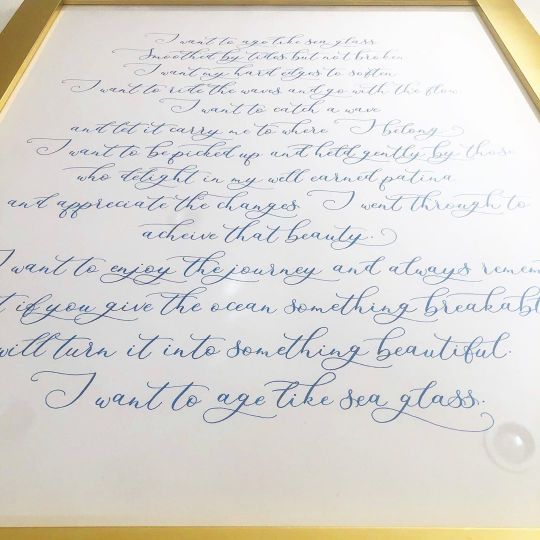
Such a beautiful quote turned into wall art for a friend 🌊 @kira8010 ty!! #calligraphy #moderncalligraphy #traditionalcalligraphy #customwallart #customartwork #bethlovespaper https://www.instagram.com/p/B9TCD8gH88K/?igshid=1hfjg3mwqxfb4
0 notes
Photo

You know your ink isn't quite dry when you hold it up to the sun for a picture and get shadows! I'm practising Engraver's Script at the moment, mostly because I fell in love with that lowercase R (and the terminals! - excuse me I need to go somewhere quiet to geek out 😉) . . #engraversscript #calligraphy #traditionalcalligraphy #practicemakesprogress #engrossers
12 notes
·
View notes
Text
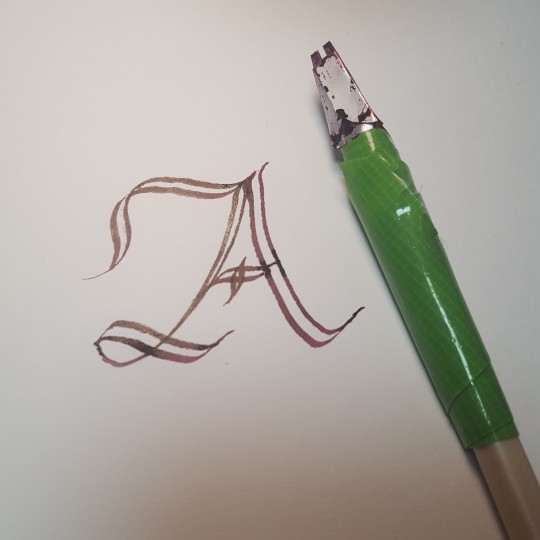

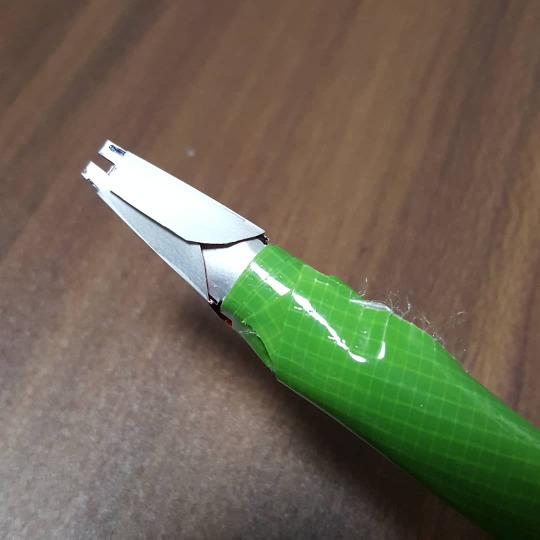
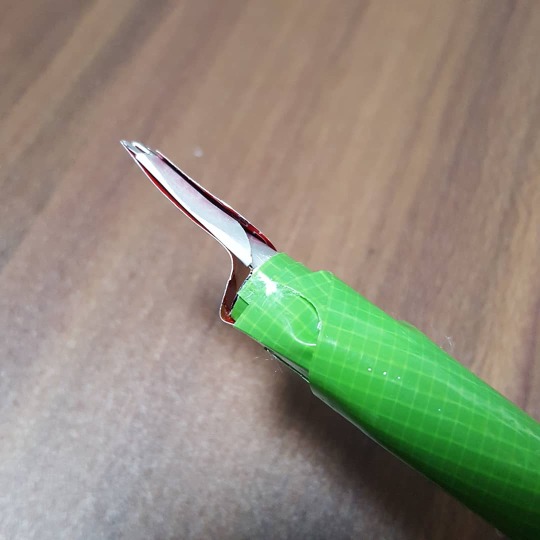
↑表 裏 横から見たところ。
#Colapen #AutomaticPen #MultiLiner
Cola pen チャレンジの一環で、オートマチックペン作りに挑戦してみた。
形にはなったけれどこれだと軸が柔らかすぎて、字が震えてしまう。一応補強を兼ねてレゼボア様の一枚をかませているのに、それでもまだ柔らかい。これ以上しっかりさせるには異素材を使うか、もっと複雑な構造にしなくてはならない?
#Lettering #HandLettering #LetteringChallenge #καλλιγραφία #kalligraphie #kalligraphy #Calligraphy #TraditionalCalligraphy
2 notes
·
View notes
Video
A little survey - I would LOVE to hear from you. What inks, nibs, and x-height do you like write at? For traditional or modern calligraphy. #moderncalligraphy #traditionalcalligraphy #calligraphy #brushcalligraphy #tools #tips #materialstudy (at London, United Kingdom) https://www.instagram.com/p/BnbEvqyguHh/?utm_source=ig_tumblr_share&igshid=ar6ua36ynjn5
0 notes
Photo

A little something something for @loewe to kick off the CNY celebration! Beautifully photo taken by @mean.xs ! Collaboration with @thegeneralco & @poptsiepaperco ! 👌🏻 Can you guys feel the CNY goodies calling already!?! ❤️😉 . . . #calligraphy #chinesecalligraphy #traditional #traditionalcalligraphy #collaborate #collaboration #eastmeetswest #chinesenewyear #loewe #luxury #cvwql #craftvaries (at Singapore)
#chinesecalligraphy#loewe#cvwql#craftvaries#eastmeetswest#collaborate#chinesenewyear#traditionalcalligraphy#collaboration#luxury#traditional#calligraphy
0 notes
Photo
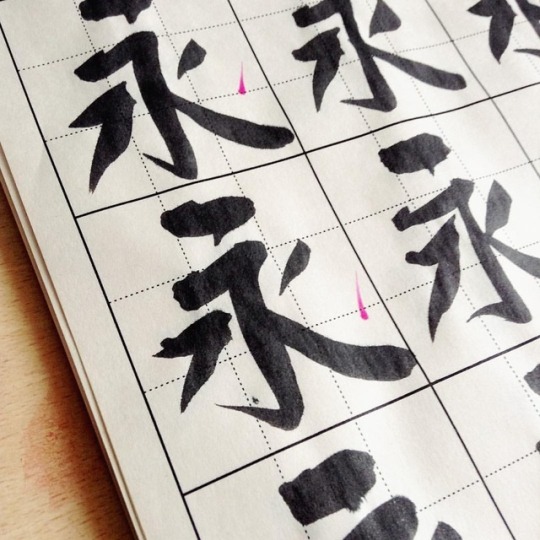
The roots of my roots> Eterno / Las raíces de mis raíces> Eternal~ - #chinesebrush #chineseletters #china #chinesecalligraphy #chinesecalligraphybrush #chinesecharacters #calligraphy #traditionalcalligraphy #moderncalligraphy #calligraphypractice #eternal #eterno #calligrafia #caligrafiachina #pincel #brushcalligraphy #lettering #handmade #handlettered #caligrafía #handpainted #louieletters
#pincel#handpainted#eternal#china#traditionalcalligraphy#chinesecalligraphybrush#lettering#chineseletters#calligrafia#brushcalligraphy#chinesecalligraphy#caligrafiachina#eterno#handmade#chinesecharacters#caligrafía#calligraphy#handlettered#calligraphypractice#moderncalligraphy#louieletters#chinesebrush
0 notes
Text
Celtic Calligraphy Art: Explore Ancient European Scripts

Celtic Calligraphy Art: A Journey Through Time with Ancient European Scripts
Discover the mesmerizing world of Celtic Calligraphy Art, an art form that draws inspiration from ancient European scripts. With its roots in Celtic culture, this unique form of artistic expression encompasses a range of styles, from intricate lettering to beautifully ornate designs. Immerse yourself in the rich traditions and beauty of Celtic Calligraphy Art as we take you on a journey through its history and influences. Key Takeaways: - Celtic Calligraphy Art is a captivating form of artistic expression that originates from ancient European scripts. - It encompasses various styles of writing, ranging from intricate lettering to beautifully ornate designs. - Irish and Scottish monasticism played a significant role in the development and spread of Celtic Calligraphy Art. - The Insular manuscripts utilized two main scripts: the majuscular script called Insular half uncial and the more cursive Irish minuscule. - Celtic Calligraphy Art had a significant influence on the Continent through Irish missionaries and the Benedictine Order.
A Brief History of Celtic Calligraphy Art

Celtic Calligraphy Art has a long and fascinating history that can be traced back to ancient times. This unique art form emerged during the 5th century as a response to the relaxation of Roman authority in Europe. Isolated places like Ireland and Britain became centers for the development of distinct book styles rooted in Celtic culture. Monasteries played a crucial role in the production of Celtic Calligraphy Art. Skilled scribes in these monastic houses meticulously crafted manuscripts, showcasing the distinctive scripts and ornamentation that define this art form. The production of these manuscripts, such as the famous Book of Kells and the Lindisfarne Gospels, showcased the intricate lettering and vibrant designs that characterize Celtic Calligraphy Art. The art of Celtic Calligraphy continued to evolve and spread, influenced by both Celtic and continental European cultures. Irish missionaries established monastic centers in Gaul, Switzerland, and Italy, spreading the art form to new regions. These monastic houses, such as St. Gall and Bobbio, became renowned for their manuscripts in the Insular style. Influence of Monasticism on Celtic Calligraphy Art "Monasteries were hubs of learning and scholarship, fostering an exchange of ideas and influences between Celtic and continental European cultures." The majuscular and minuscule scripts were the main writing styles used in Celtic Calligraphy Art manuscripts. The majuscular script, also known as Insular half uncial, was used for fine books like the Book of Kells and the Lindisfarne Gospels. It showcased a high degree of conformity and stylistic maturity, incorporating intricate interlacements and colorful ornamentation. The more cursive Irish minuscule script, on the other hand, was used for documents and vernacular texts. These ancient scripts and ornamentation found in Celtic Calligraphy Art have deep-rooted symbolism and were considered sacred. They reflect the rich cultural heritage and advanced thinking of our ancestors. The intricate lettering and vibrant designs continue to captivate and inspire artists and enthusiasts of Celtic Calligraphy Art today. Influences and Spread of Celtic Calligraphy Art Irish and Scottish Monasticism Continental Influences Played a significant role in the development and spread of Celtic Calligraphy Art Irish missionaries established monastic centers in Gaul, Switzerland, and Italy Monastic houses like Iona and Lindisfarne were renowned for their manuscripts Monastic centers like St. Gall and Bobbio became hubs for the art form Produced manuscripts like the Book of Kells and the Lindisfarne Gospels, showcasing intricate lettering and ornamentation Benedictine Order played a crucial role in the production and preservation of Celtic Calligraphy Art
The Influence of Irish and Scottish Monasticism
Irish and Scottish monasticism played a significant role in the development and spread of Celtic Calligraphy Art. Monasteries like Iona and Lindisfarne were renowned for their scriptoriums, where skilled scribes meticulously crafted manuscripts. These monastic houses became hubs of Christian learning and scholarship, fostering an exchange of ideas and influences between Celtic and continental European cultures. The manuscripts produced in these monasteries, such as the Book of Kells and the Lindisfarne Gospels, showcase the intricate lettering and vibrant ornamentation that define Celtic Calligraphy Art. Irish calligraphy, with its distinct style characterized by decorative elements and elaborate knotwork, became highly influential in the development of Celtic Calligraphy Art. The script utilized in Irish manuscripts, known as Insular script, displayed intricate interlacements and vibrant ornamentation, combining both majuscular and minuscule scripts. This unique fusion of styles, influenced by both Celtic and continental European traditions, contributed to the distinctive and visually captivating nature of Celtic Calligraphy Art. Scottish calligraphy also made significant contributions to Celtic Calligraphy Art. The monastic community of Iona, located on the west coast of Scotland, played a crucial role in the preservation and advancement of Celtic artistic traditions. Skilled Scottish scribes created manuscripts that featured intricate knotwork, zoomorphic designs, and calligraphic excellence. These manuscripts not only celebrated the beauty of the written word but also served as symbols of religious devotion and adherence to the monastic ideals. Monastic Community Location Influence Iona Scotland Preservation and advancement of Celtic artistic traditions Lindisfarne England Production of intricately crafted manuscripts Bobio Italy Spread of Celtic Calligraphy Art to continental Europe The influence of Irish and Scottish monasticism on Celtic Calligraphy Art cannot be overstated. These monastic communities served as centers of artistic excellence and spiritual devotion, nurturing the development of this unique art form. Through their manuscripts, these medieval scribes created timeless works of art that continue to captivate and inspire audiences today.
Celtic Calligraphy Art: The Majuscular and Minuscule Scripts

Within the realm of Celtic Calligraphy Art, the Insular manuscripts stand out as magnificent showcases of skill and creativity. These manuscripts utilized two main scripts: the majuscular script known as Insular half uncial and the more cursive Irish minuscule. Each script had its own distinct characteristics and purpose within the art form. "The majuscular script, also referred to as the Insular half uncial script, was particularly suited for fine books like the Book of Kells and the Lindisfarne Gospels. It displayed a high level of conformity and stylistic maturity, incorporating intricate interlacements and vivid ornamentation," The majuscular script contributed to the overall grandeur and intricacy of Celtic Calligraphy Art. It exemplified the attention to detail and craftsmanship that defined this ancient art form. In contrast, the Irish minuscule script was used for more practical purposes, such as documents and vernacular texts. Its cursive nature allowed for faster writing, making it suitable for everyday use. While less ornate than the majuscular script, the Irish minuscule still possessed a unique charm and elegance. The Majuscular and Minuscule Scripts: A Comparison Majuscular Script (Insular half uncial) Irish Minuscule Used for fine books Used for documents and vernacular texts Intricate interlacements and colorful ornamentation Less ornate but still elegant High level of conformity and stylistic maturity Cursive nature allows for faster writing This comparison table highlights the key differences between the majuscular and minuscule scripts, showcasing their individual characteristics within the realm of Celtic Calligraphy Art. Each script contributed to the rich tapestry of this ancient art form, capturing the attention and admiration of art enthusiasts and historians alike. The intricate majuscular and practical minuscule scripts are testaments to the skill and creativity of the scribes who crafted these manuscripts. Through their craftsmanship, Celtic Calligraphy Art continues to captivate and inspire, preserving a unique piece of history and culture.
Continental Influences on Celtic Calligraphy Art

Celtic Calligraphy Art, with its rich history and distinctive styles, was not limited to the British Isles. It also had a significant impact on the Continent, spreading through the efforts of Irish missionaries and the influence of the Benedictine Order. St. Columban, an influential Irish missionary, established monasteries in Gaul, Switzerland, and Italy, bringing the art of Celtic Calligraphy to new regions. One of the most renowned centers of Celtic Calligraphy Art on the Continent was the monastery at St. Gall in Switzerland. The monks at St. Gall produced exquisite manuscripts in the Insular style, characterized by intricate lettering and vibrant ornamentation. These manuscripts served as important cultural links between the Celtic and continental European cultures. The art of Celtic Calligraphy traveled far beyond the British Isles, leaving an indelible mark on the Continent. Through the efforts of Irish missionaries like St. Columban and the influence of the Benedictine Order, this unique art form found a new home on the European mainland, shaping the development of calligraphy throughout the region. Another significant center of Celtic Calligraphy was the monastery at Bobbio in Italy, founded by St. Columban's disciple, Bobbio. The monastic community at Bobbio produced manuscripts that showcased the beauty of Celtic script and ornamentation, further spreading the influence of Celtic Calligraphy Art in continental Europe. Saint Gall Monastery: A Hub of Celtic Calligraphy The monastery at St. Gall became a thriving center for Celtic Calligraphy Art, attracting scholars and artists from far and wide. The monks diligently copied and illuminated manuscripts, creating stunning works of art that showcased the unique lettering and decorative motifs of Celtic Calligraphy. These manuscripts not only preserved ancient knowledge but also served as a source of inspiration for future generations of calligraphers. The Benedictine Order and Celtic Calligraphy Art The Benedictine Order, known for its dedication to scholarship and artistry, played a key role in the production and preservation of Celtic Calligraphy Art. The motherhouse of the Benedictine Order at Monte Cassino in Italy became a center of artistic excellence, where Celtic scripts were studied and integrated into the broader tradition of calligraphy. The influence of continental Europe on Celtic Calligraphy Art is a testament to the interconnectedness of cultures and the power of artistic expression to transcend geographical boundaries. Through the efforts of individuals such as St. Columban and the dedication of monastic communities, Celtic Calligraphy Art flourished both within the British Isles and beyond, leaving a lasting legacy in the annals of European art.
Celtic Calligraphy Art: A Sacred Script of Ancient Marks in Old European Cultures

The ancient marks and symbols found in Celtic Calligraphy Art hold a deep-rooted significance, representing a sacred script that was revered in Old European cultures. These abstract signs and inscriptions can be traced back to prehistoric times, with evidence of their existence in cave paintings and ritual objects. They were believed to communicate profound ideas and spiritual concepts, reflecting the reverence for natural cycles and divine forces. Archaeological discoveries in Old European cultures, such as Vinca and Danube, have shed light on the use of these ancient marks in various forms of art. They were often found alongside realistic animal paintings in Paleolithic caves, indicating that they held symbolic meaning for the artists. These symbolic representations of female and male symbols provide a glimpse into the advanced thinking and spirituality of our ancestors. "The marks and symbols found in Celtic Calligraphy Art are not mere decorative elements but carry a profound spiritual significance. Through these abstract signs, our ancestors sought to communicate with the divine forces and express their reverence for the natural world." The Symbolism in Celtic Calligraphy Art The symbolism embedded in Celtic Calligraphy Art goes beyond mere aesthetics. Each mark and symbol carries its own unique meaning, often rooted in ancient mythology and folklore. The spirals, knots, and interlacements found in Celtic designs symbolize the interconnectedness of life and the eternal cycle of birth, death, and rebirth. The intricate patterns and flow of lines in Celtic writing reflect the harmony and balance believed to exist in the natural world. Symbol Meaning Triskele Represents the threefold nature of existence: life, death, and rebirth. Spiral Symbolizes growth, expansion, and the continuous journey of self-discovery. Knotwork Reflects the interconnectedness of all things and the eternal cycle of life. Tree of Life Signifies the connection between the physical and spiritual realms, and the belief in the interconnectedness of all living beings. Celtic Calligraphy Art serves as a powerful reminder of our ancient roots and the wisdom of our ancestors. By exploring the sacred script of these ancient marks, we can gain a deeper understanding of the rich cultural heritage and spiritual beliefs that have shaped our world.
Prehistoric Origins of Writing
https://www.youtube.com/watch?v=2_ygBp_qM3c Before the emergence of Sumerian cuneiform, writing had its prehistoric origins in ancient marks and symbols. Evidence from Old European cultures suggests that writing may have existed even earlier than previously believed. These ancient marks, found in cave paintings and ritual objects, held symbolic meaning and provided a means of communication for our ancestors. Unlike the complex systems of later civilizations, prehistoric writing was often logographic or ideographic, representing entire words or concepts in single symbols. This form of writing can be seen in ancient cultures such as the Chinese and Japanese scripts. The diversity of ancient writing systems highlights the evolving nature of writing throughout history. While much remains unknown about prehistoric writing, it is clear that these early forms of communication laid the foundation for the development of written language and the artistic expression that would evolve into Celtic Calligraphy Art. Celtic Calligraphy Art and Ancient Marks Celtic Calligraphy Art draws inspiration from the ancient marks and symbols that were prevalent in prehistoric times. These ancient symbols, which were often abstract in nature, held deep-rooted significance and were believed to communicate ideas and spiritual concepts. The intricate and artistic nature of Celtic Calligraphy Art can be traced back to these ancient marks, reflecting the advanced thinking and creativity of our ancestors.
Ancient Marks and Symbols
Dive into the captivating world of Celtic Calligraphy Art and explore the rich history of ancient marks and symbols. These enigmatic signs were prevalent in various forms of art, including cave paintings found in Paleolithic caves. Scholars have discovered a fascinating combination of abstract signs alongside realistic animal paintings, suggesting that these marks held symbolic meaning for the talented artists of ancient times. The ancient marks and symbols found in Celtic Calligraphy Art offer a glimpse into the beliefs and values of our ancestors. These abstract signs often represented female and male symbols, reflecting the importance of fertility and the cycle of life. They serve as a fascinating link to our prehistoric past and provide insights into the profound spiritual connections our ancestors had with the natural world. Cave paintings adorned the walls of Paleolithic caves, serving as a visual language that communicated ideas and concepts. Through this ancient form of expression, our ancestors conveyed their connection to the world around them and their reverence for the forces of nature. Celtic Calligraphy Art draws inspiration from these ancient marks, allowing us to experience the awe-inspiring legacy of our early human ancestors.
FAQ
What is Celtic Calligraphy Art? Celtic Calligraphy Art is a captivating form of artistic expression that draws inspiration from ancient European scripts. It encompasses various styles of writing, ranging from intricate lettering to beautifully ornate designs. When did Celtic Calligraphy Art emerge? Celtic Calligraphy Art emerged during the 5th century in response to the relaxation of Roman authority in Europe. It developed in isolated places like Ireland and Britain, becoming centers for the development of unique book styles rooted in Celtic culture. How did Irish and Scottish monasticism influence Celtic Calligraphy Art? Irish and Scottish monasticism played a significant role in the development and spread of Celtic Calligraphy Art. Monasteries like Iona and Lindisfarne were renowned for their scriptoriums, where skilled scribes meticulously crafted manuscripts. What scripts were used in Insular manuscripts? Insular manuscripts utilized two main scripts: the majuscular script called Insular half uncial and the more cursive Irish minuscule. The majuscular script was suitable for fine books, incorporating intricate interlacements and colorful ornamentation, while the Irish minuscule was used for documents and vernacular texts. Where did Celtic Calligraphy Art spread to? Celtic Calligraphy Art had significant influence on the Continent, thanks to Irish missionaries like St. Columban. Monasteries such as St. Gall and Bobbio became renowned for their manuscripts in the Insular style. The Benedictine Order also played a crucial role in the production and preservation of Celtic Calligraphy Art. What is the symbolism behind Celtic Calligraphy Art? The marks and symbols found in Celtic Calligraphy Art have deep-rooted symbolism and were considered a sacred script in ancient times. They communicate ideas and spiritual concepts, often associated with the reverence for natural cycles and divine forces. How far back can the origins of writing be traced? The origins of writing can be traced back to prehistoric times. Evidence of marks and symbols has been found in Old European cultures, challenging the traditional view that Sumerian cuneiform was the first form of writing. How were ancient marks and symbols incorporated into art? Read the full article
#AncientScriptsArt#CelticScriptDesign#EuropeanCalligraphy#HistoricalLettering#TraditionalCalligraphy
0 notes
Photo

The beauty of traditional calligraphy! Wrote in modern gothic script using @manuscriptpenco calligraphy pens! Day 4 of #lettersinmystyle challenge. #traditionalcalligraphy #traditionalcalligraphyfonts #calligraphy #calligraphylettering #calligraphyart #calligraphylove #calligraphypractice #calligraphydaily #calligraphyartist #calligraphycommunity #calligraphyaddict #lettering #letteringdaily #letteringlove #letteringcommunity #letteringuk #letteringlover #martinluther #martinlutherquotes https://www.instagram.com/p/CSeXjWMM0E0/?utm_medium=tumblr
#lettersinmystyle#traditionalcalligraphy#traditionalcalligraphyfonts#calligraphy#calligraphylettering#calligraphyart#calligraphylove#calligraphypractice#calligraphydaily#calligraphyartist#calligraphycommunity#calligraphyaddict#lettering#letteringdaily#letteringlove#letteringcommunity#letteringuk#letteringlover#martinluther#martinlutherquotes
1 note
·
View note
Photo
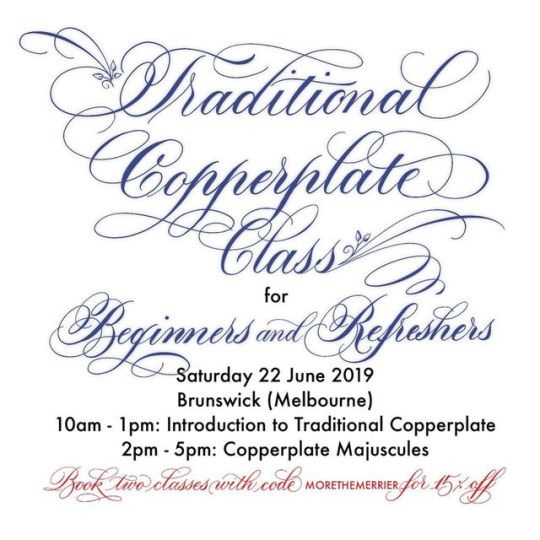
I don’t think I’ll ever get the results with iPad lettering that I do with pen and paper ... but I’m improving. Anyway, it’s your standard post about upcoming classes in Melbourne! Going to do a full day of calligraphy magic - starting with the basics and miniscule, and working on capitals in the afternoon. I would love to have you for half or all. Link in profile, or just go to www.calligraphybymoya.com.au/workshops! . You don’t need to bring anything (but you’re welcome to bring your fave oblique holder) - class kit includes paper, ink, nibs, and, for the morning class, a @luis.creations mOblique holder, because I love them. ❤️😅 . (If you come for the full day, or actually any time you book more than one class at once, so if you bring a friend, then use code MORETHEMERRIER for a discount!) . Also, I’m looking around at my options for venues to teach in. Any cool suggestions? . Happy Friday everyone! I’m working on so many things and I’m running behind on so many things. I think I need a holiday to recover from my Brisbane holiday. Isn’t that always the way! . #calligraphy #calligraphyclass #calligraphyclasses #melbourne #melbourneartists #handlettering #handwriting #writebyhand #typegang #lovemyjob #calligraphyteacher #melbourne_insta #letternerd #handlettering #traditionalcalligraphy #copperplateclasses #comeplaywithme (at Brunswick, Victoria) https://www.instagram.com/p/BxjQQ77F03o/?igshid=1ukuzrzdjwoey
#calligraphy#calligraphyclass#calligraphyclasses#melbourne#melbourneartists#handlettering#handwriting#writebyhand#typegang#lovemyjob#calligraphyteacher#melbourne_insta#letternerd#traditionalcalligraphy#copperplateclasses#comeplaywithme
3 notes
·
View notes
Photo
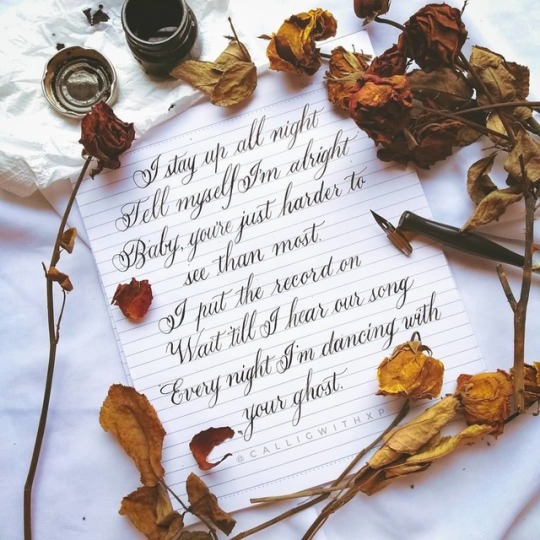
Every night I'm dancing with your ghost. . . Lyrics from Dancing With Your Ghost by @sadgirlsloan . . Mats Used ✔️ Daiso Calligraphy Ink ✔️ Nikko G nib ✔️ Oblique pen holder ✔️ Easywrite intermediate paper . . #Calligraphy #calligraphyph #keepwriting #lettering #handletteringchallenge #handlettering #calligrafriendsph #calligraphymasters #letteringbox #calligrapher #calligraphylove #HOMwork #thedailycalligraphy #thecalligraphyhub #kaligraflar #typographyinspired #typism #goodtype #typegang #CalligraphySOX #GensanCalligraphers #artist #calligraphyhub #traditionalcalligraphy (at General Santos City) https://www.instagram.com/p/Bzw7WIDn7P8/?igshid=6bd6rhnbuuqk
#calligraphy#calligraphyph#keepwriting#lettering#handletteringchallenge#handlettering#calligrafriendsph#calligraphymasters#letteringbox#calligrapher#calligraphylove#homwork#thedailycalligraphy#thecalligraphyhub#kaligraflar#typographyinspired#typism#goodtype#typegang#calligraphysox#gensancalligraphers#artist#calligraphyhub#traditionalcalligraphy
6 notes
·
View notes
Photo

I 💙 love letters!! This is a poem written for an anniversary, so romantic! @redmondsmama .... #bethlovespaper #calligraphy #moderncalligraphy #traditionalcalligraphy #loveletter #handwritten #customartwork #wallart #anniversary #anniversarygift https://www.instagram.com/p/B7o1ojnB9xc/?igshid=jlw91pqrm338
#bethlovespaper#calligraphy#moderncalligraphy#traditionalcalligraphy#loveletter#handwritten#customartwork#wallart#anniversary#anniversarygift
0 notes
Video
instagram
Calligraphy is not a FONT. It is the art of producing a handwriting or lettering with a pen, pencil, brush or whatever tool you can use to write. You can do calligraphy with any kind of pen. How cool is that? . . Video taken in real-time 🖊 Uniball SIGNO 📝 Monte Marte Black Sketch Pad . #calligraphy #whiteonblack #blackandwhite #calligraphyph #typography #typematters #calligraphyvideo #handlettering #traditionalcalligraphy #moderncalligraphy #handmadetype #goodtype #typedrawn #typedesign #thedesigntip #thedailytype #thedailycalligraphy #thedesignfix #tyxca #50words #letteringco #uniball #kayelligraphy #karlangelikaye #hyperlapse #handmadefont #oddlysatisfying #montemarte #whiteink #ink
#montemarte#karlangelikaye#thedailycalligraphy#calligraphy#letteringco#handmadetype#thedailytype#50words#handmadefont#calligraphyvideo#uniball#calligraphyph#thedesignfix#tyxca#kayelligraphy#typedrawn#typematters#typedesign#blackandwhite#whiteonblack#goodtype#moderncalligraphy#thedesigntip#ink#handlettering#traditionalcalligraphy#typography#whiteink#oddlysatisfying#hyperlapse
2 notes
·
View notes